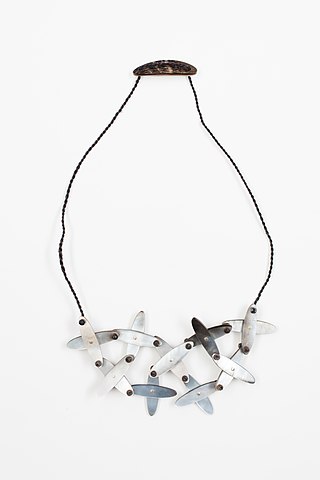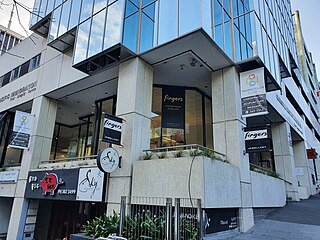Related Research Articles

The Dowse Art Museum is a municipal art gallery in Lower Hutt, New Zealand.
Paul Rayner is an English-New Zealand ceramicist known for his work creating pop culture figures in the tradition of Toby jugs and Staffordshire figurines.
Kobi Bosshard is a Swiss-born New Zealand jeweller. Bosshard was one of a number of European-trained jewellers who came to New Zealand in the 1960s and transformed contemporary jewellery in the country; others include Jens Hoyer Hansen, Tanya Ashken and Gunter Taemmler.

Alan Chris Preston is a New Zealand jeweller. His work has been exhibited widely in New Zealand and internationally, and is held in major public collections in New Zealand.
Octavia Cook is a New Zealand jeweller.
Warwick Stephen Freeman is a New Zealand jeweller.
Pauline Bern is a New Zealand jeweller.

Fingers is a contemporary jewellery gallery in Auckland, New Zealand. Fingers shows and sells the work primarily of New Zealand jewellers, but also of international jewellers, mostly from Australia and Europe.
Niki Hastings-McFall is a New Zealand jeweller and artist of Samoan and Pākehā descent. She has been described by art historian Karen Stevenson as one of the core members of a group of artists of Pasifika descent who brought contemporary Pacific art to 'national prominence and international acceptance'.

Lisa Walker is a contemporary New Zealand jeweller.
Pacific Sisters is a collective of Pacific and Māori artists, performers, fashion designers, jewellers and musicians.
Andrea Daly is a New Zealand jeweller and arts teacher. She studied at Sydney College of the Arts, completing a Bachelor of Visual Arts in 1987. The following year, she gained a Post Graduate Diploma in Visual Arts majoring in contemporary jewellery. In 1998, she completed a master's degree in Philosophy majoring in Art History at Auckland University
Tania Patterson is a New Zealand jeweller. She graduated from Auckland's UNITEC Institute of Technology in 1989 with a Diploma in Craft and Design.
Areta Rachael Wilkinson is a New Zealand jeweller.
Ngataiharuru Taepa is a New Zealand artist of Māori and Pākehā descent.
Ioane Ioane is a New Zealand artist of Samoan descent. His work is informed by his Samoan heritage and includes performance, film, painting, installation and sculpture. In conversation about his work Fale Sā with art historian Caroline Vercoe, Ioane states, Sacred places are not necessarily a church, but it's a place where one likes to be in, a place of affirmation. Curator Ron Brownson writes, Ioane's attitude to sculptural process is cosmological – his carvings bind present reality with a representation of the past.
Paul Geoffrey Annear was a New Zealand contemporary jeweller.

Māngere Arts Centre - Ngā Tohu o Uenuku is an Auckland Council-owned and operated arts venue in the suburb of Māngere, in Auckland, New Zealand. The purpose-built facility was opened in 2010, and is considered by Auckland Council to be the home of Māori and Pacific visual art and performing arts in Auckland.
Kaetaeta Watson is a master weaver from Kiribati. Her art work and collaborations advocate for and support the maintenance and transmission of Kiribati culture and heritage.

Louisa Murdoch Humphry is a I-Kiribati artist and master weaver with over thirty years of experience. Humphry grew up in Kiribati and now resides in New Zealand. In 2019, her work was recognised with a Pacific Heritage Artist Award alongside Kiribati artist Kaetaeta Watson at the Arts Pasifika Awards. In 2021, she was appointed an honorary Member of the New Zealand Order of Merit, for services to the Kiribati community and culture.
References
- ↑ "Chris Charteris". Find NZ Artists. Retrieved 17 December 2014.
- 1 2 3 4 "Chris Charteris". Tautai: Guiding Pacific Arts. Retrieved 17 December 2014.
- ↑ Barnett, Gerald. "Chris Charteris" (PDF). Real Art Road Show. Retrieved 17 December 2014.
- 1 2 "Chris Charteris". FhE Galleries. Archived from the original on 17 December 2014. Retrieved 17 December 2014.
- 1 2 "Chris Charteris". Koru Gallery. Retrieved 17 December 2014.
- ↑ Crowe, Deborah (2001). 4th New Zealand Jewellery Biennale: Grammar: Subjects and Objects (PDF). Lower Hutt: The Dowse Art Museum. ISBN 0958341451.
- ↑ Bell, Richard. The Third New Zealand Jewellery Biennial: Turangawaewae: A Public Outing (PDF). Lower Hutt: The Dowse Art Museum. ISBN 0958341443.
- ↑ Skinner, Damian; Murray, Kevin (2014). Place and Adornment: A history of contemporary jewellery in Australia and New Zealand. Honolulu: University of Hawai'i. p. 190. ISBN 9781454702771.
- ↑ Stevenson, Karen (2008). The frangipani is dead: contemporary Pacific art in New Zealand, 1985-2000. Wellington: Huia Publishers. p. 150. ISBN 9781869693251.
- ↑ "Exploring the spaces between". Art News New Zealand: 85–86. Summer 2010.
- ↑ "Tungaru : the Kiribati project : Auckland War Memorial Museum, 5 July - 23 November 2014, Mangere Arts Centre - Nga Tohu o Uenuku, 12 July - 24 August 2014". Auckland War Memorial Museum . Retrieved 23 January 2022.
- ↑ "Tungaru: The Kiribati project". Creative New Zealand. Archived from the original on 24 December 2014. Retrieved 24 December 2014.
- ↑ "Tungaru: The Kiribati Project". Scoop.co.nz. Retrieved 24 December 2014.
- ↑ Amery, Mark (2014). Tungaru: the Kiribati project. Whitianga: Chris Charteris and Jeff Smith. ISBN 9780473291495.
- ↑ "Tungaru: The Kiribati project". Pataka Museum + Art. Archived from the original on 24 September 2015. Retrieved 8 February 2015.
- ↑ "Tungaru: The Kiribati Project". Hastings City Art Gallery. Retrieved 14 June 2015.
- ↑ "Collections Online - Made by: Chris Charteris". Auckland War Memorial Museum . Retrieved 23 January 2022.
- ↑ "Works by Chris Charteris in the collection of the Museums of New Zealand Te Papa Tongarewa" . Retrieved 12 October 2016.